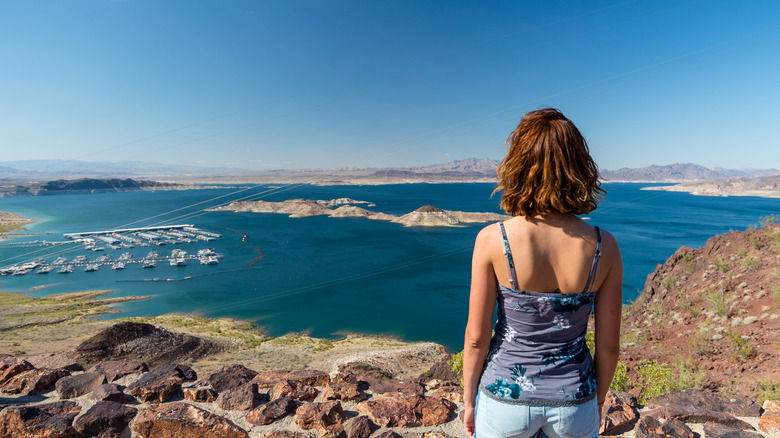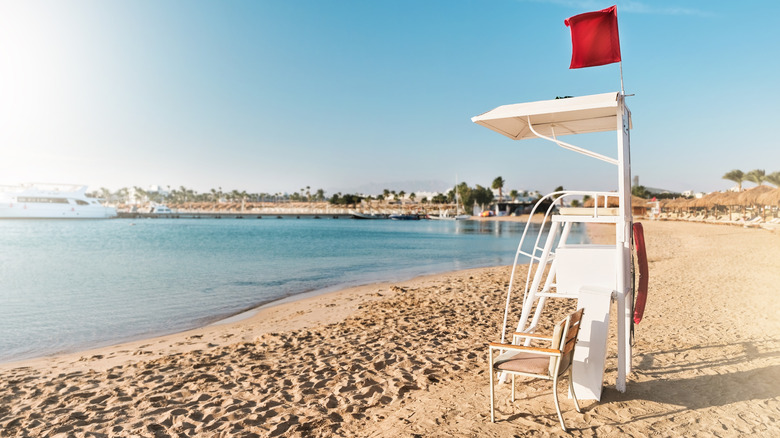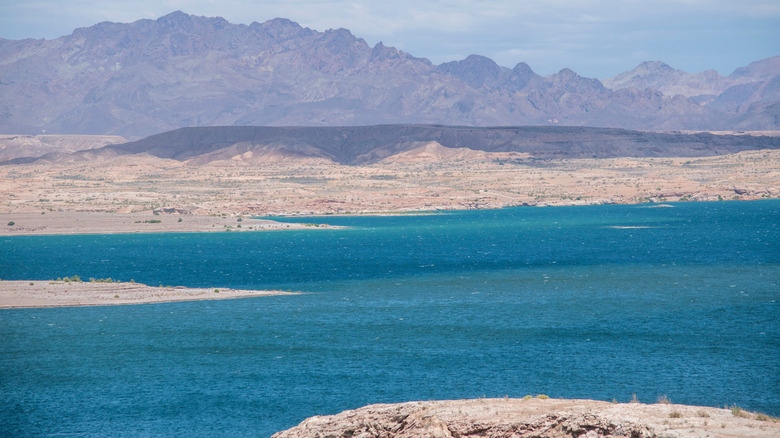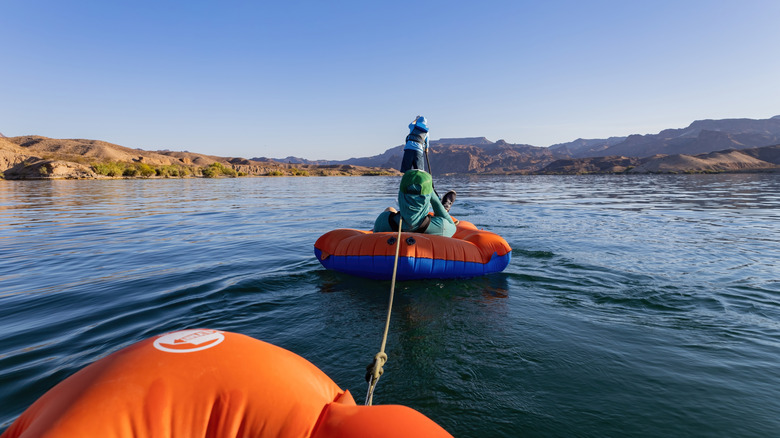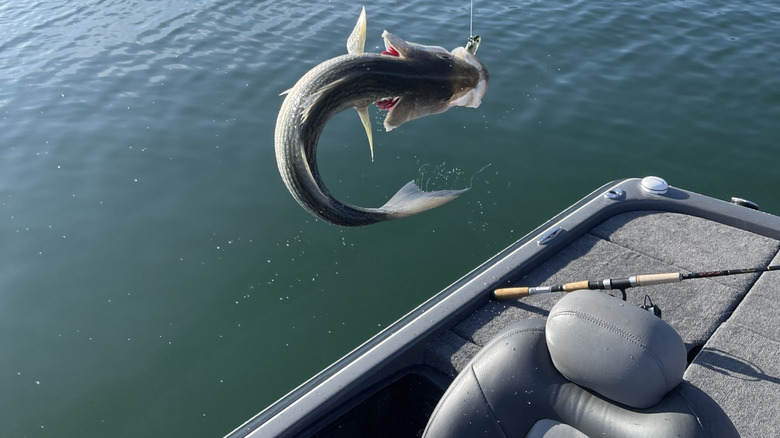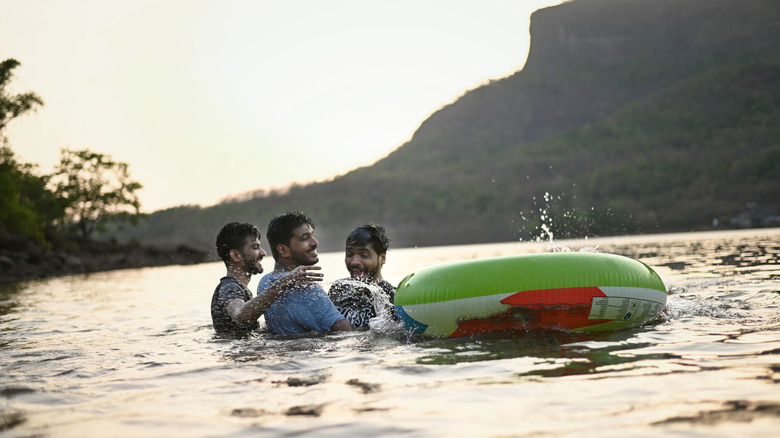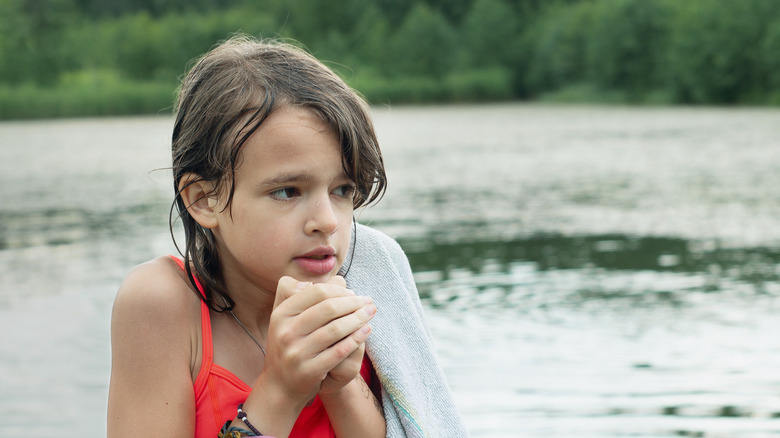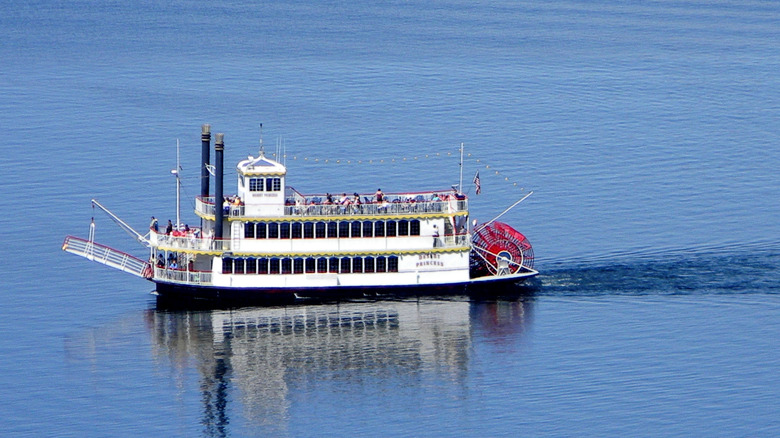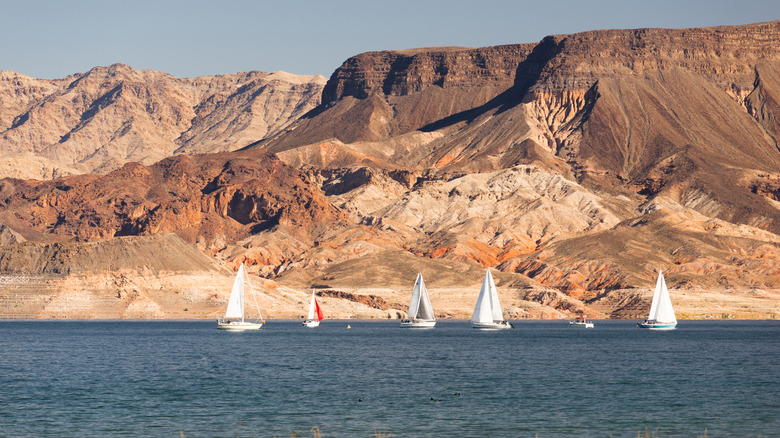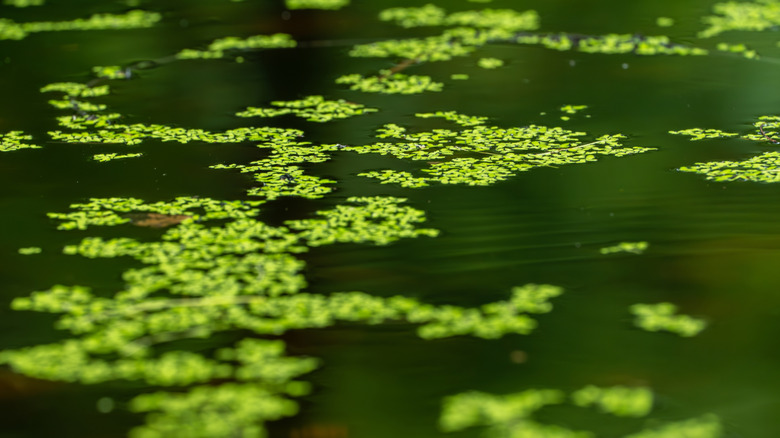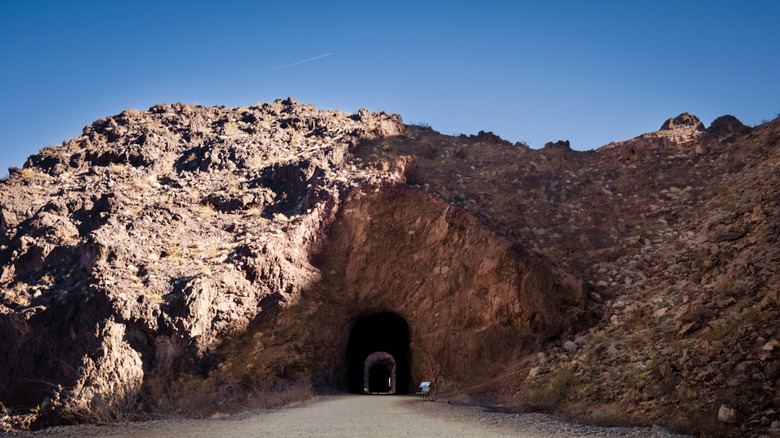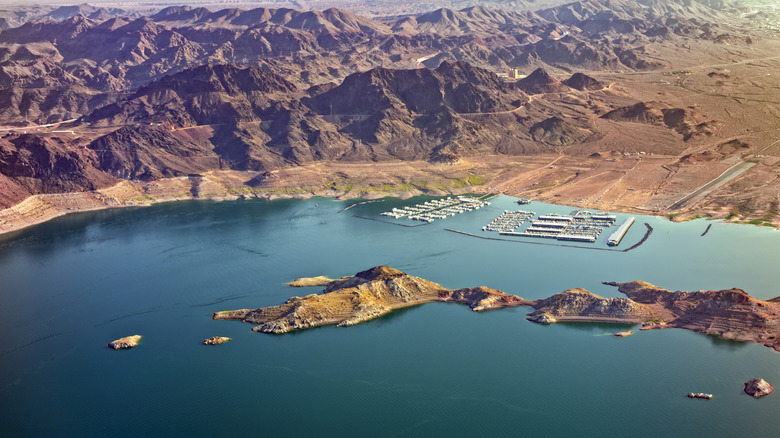11 Lake Mead Details To Know Before Visiting
You would never know from visitor numbers that Lake Mead is considered the most dangerous national park in the U.S. Visitors flock to the recreation-filled area for hiking, swimming, boating, fishing, paddle boarding, and more. In fact, in 2024, Lake Mead had 6.4 million visitors, rivaling Zion National Park, the second most-visited national park, which got only 4.9 million. But while the man-made lake is undoubtedly fun, there is a darker side that consistently makes the popular recreation area a subject of regional and national news.
A range of incidents contribute to this darker reputation. From deadly heat strokes to a high number of annual drownings, the popular lake and its surrounding area seem rife with danger. Still, visitor numbers continue to increase in recent years. It seems that with all its potential dangers, Lake Mead will remain a fixture in people's outdoor recreation plans. If you're part of the group planning on visiting the area, it's worth noting the details around the dangers of the area. Not only can you more fully prepare if you know what to expect, but you may even save your life.
Safety isn't the only concern you may have about visiting Lake Mead. With its acres of activities and relaxation, the area is popular for day trips to escape the fun, touristy thrills of nearby Las Vegas, aka "the most fun city in America." These trips demand efficient planning if you're to take full advantage of everything the area has to offer within the limited time you may have. In addition to the safety details, we've rounded off this list with important trip — planning details that will help you plan a fun day before you arrive.
Lake Mead has no lifeguards, so be extra cautious
With approximately 1,000 miles of shoreline extending along the borders of Nevada and Arizona, Lake Mead National Recreation Area, which includes Lake Mohave, countless beaches, and other swimming holes, is a hot spot for water activities. Considering that, you might expect to find multiple lifeguards scattered around the recreational areas. This is not so.
Lake Mead warns on its official website that the park does not provide lifeguards at any of its many swimming spots. Given this fact it would be understandable if you wanted to skip Lake Mead for one of Nevada's other breathtaking lakes. But if you have your heart set on Lake Mead, maintaining vigilance about keeping yourself safe in the water is a good idea. The most important precaution to take is to always wear a life jacket, even if you're on a boat or consider yourself and your family to be strong swimmers.
The major incidents of drowning on Lake Mead weren't due to a lack of swimming skill, but to circumstances that only a life jacket could have helped in a majority of the cases. In 2024, a teenager drowned after tumbling off a shelf (via KTNV 13 Las Vegas). The shelf's drop-off led to dangerous waters and he was not wearing a life jacket that could have kept him afloat until help to arrive. In 2023, according to the Las Vegas Review-Journal, one drowning was due to high winds that blew a boat away from visitors who had left the safety of the vessel to enjoy the water. If you don't own a life jacket, you can easily get a free one for the day at the park.
Lake Mead experiences high winds that can make swimming dangerous
Swimming during high wind is unsafe anywhere, but particular features of Lake Mead's weather patterns make it exceptionally dangerous. The swimming destination sits in an area that has a monsoon season that can bring dangerous thunderstorms and rain. To make matters worse, this season happens to coincide with summer when visitor numbers are highest. The period between October and May also sees dangerous winds that can make swimming conditions unsafe.
These windy conditions have been responsible for numerous accidents and deaths. In August 2023, winds from a monsoon created a scare for boaters who suddenly found themselves in dangerous waters. Luckily, they were rescued. But In that same report, another boater whose boat got swept away ultimately died.
To keep yourself safe, leave the water if it gets windy. If you're on a boat, sail away from open waters and shelter under a protected cove. Consider wearing a life jacket, whether swimming, boating, or enjoying a water sport like kayaking or paddle boarding. It's also a good idea to check Lake Mead's official social media pages on the day you plan to visit. The park publishes daily advisories that may save you a trip if the weather conditions are too dangerous for swimming.
You can easily rent your equipment for the day
Lake Mead can be an amazing, nature-filled destination if you've taken necessary precautions. And the recreation area makes enjoying its pristine outdoor environment easy. Whether you want to go out on the blue waters on a boat, go horseback riding on rugged back country trails, or enjoy a day of fishing, you can rent equipment or purchase guided excursions that do all the planning so you can simply show up and enjoy.
If you want to spend the day on a boat, you'll find private concessions renting houseboats, small boats, jet skis, and non-motorized vessels like kayaks and paddle boards. Some, like Cottonwood Cove Resort, have full RV campgrounds and other accommodations like a houseboat hotel where you can stay if you plan on spending an extended holiday at Lake Mead. Others, like Lake Mead Cruises, offer themed cruises like brunch cruises and a fun Parade of Lights Cruise around the holidays.
The emerald waters of the nearby picturesque Willow Beach Marina is also chock full of excursions with kayaking being a specialty. You can also easily arrange guided fishing expeditions and bicycle tours around the back country roads.
You need permits for some activities
The Lake Mead National Recreation Area sprawls over more than 1.5 million acres. Like many of America's other fun lake vacation destinations, the outdoor attractions in this expansive area can be enjoyed by simply showing up and purchasing a pass. But some more niche activities require permits or licenses before they can be enjoyed.
If you plan on fishing, the license you need will depend on what part of Lake Mead you plan on fishing. If you're fishing the Arizona section, you'll need a state-issued license for anyone 10 years and older, even if you don't reside in Arizona. The only exception to this, is if you're sight impaired. The Nevada sections of Lake Mead will require a license for everyone older than 12 years old as well as permits for your boat. Check with the Arizona Game and Fish Department or the Nevada Department of Wildlife for locations and license prices.
If you plan on going out on the water on a motorized vessel of any kind, you'll need to purchase a vessel pass at the park as well as comply with these other state-specific requirements. For hunting, you'll need a specific license depending on what section of the lands surrounding Lake Mead you'll be hunting on. In Nevada, you'll need to purchase a hunting license, along with tags for big game (if applicable). If your plans involve hunting in Arizona, just as with fishing excursions, all members of your party over 10 years old will need a license. Arizona Game and Fish Department, and Nevada Department of Wildlife both have helpful websites if you need more information.
Pool toys are banned
Come summer, families across the nation get ready for swimming season. Sand shovels, sunscreen, and pool toys fly off the shelves. These seem innocent enough, but they can be hazardous to use on Lake Mead. In a news report from Las Vegas' NBC news affiliate, News 3 Las Vegas, Lake Mead park officials issued a statement warning that pool toys like wearable water wings and inflatables lead to deadly accidents because swimmers using them sometimes take risks thinking that these toys will protect them and keep them afloat if something dangerous happens. But the fact is, they do not prevent drowning.
According to the same report, pool toys played a part in nine drownings in the seven years preceding 2021. This prompted Lake Mead to ban them, which is understandable when you consider their dangers. Pool toys, especially wearable inflatable ones, may seem like they offer safety, but their design and construction cause them to easily deflate. This is just another reason why it's best to get a United States Coast Guard sanctioned life jacket.
There is also the problem of them being easily blown away when winds pick up. Speaking in a news article from St. George News, the public affairs official for Lake Mead, John Hayes, explained how pool toys have led to kids drowning, saying, "You may have kids out in a designated swimming area on a pool toy. The wind picks up, and all of a sudden, they're blowing a quarter a mile away into the water before anybody notices." With the danger they can bring, it's a good idea to leave them at home if you're traveling with kids.
Water temperatures can cause shock, even in summer
Imagine you've visited Lake Mead on a warm day. The weather is perfect, the day is still, and others are swimming safely in the water. Yet the temperature of the water when you jump in leads to life-changing catastrophe. This is exactly what happened to Jorge Luna. On July 20, 2014, after watching his family swimming safely in the lake, he also jumped in to enjoy a swim. However, in minutes, his body had frozen, rendering his limbs useless. Unfortunately, his partner couldn't save him and he sadly passed away from the incident.
His story was reported in Boulder City Review, with a warning from Nick Duhe, the Nevada Department of Wildlife boating education coordinator, that even when it feels hot, Lake Mead can have unexpected spots of cold water that can disable muscles. This is called cold shock, a condition where a sudden jolt from cold water impacting people's heart, lungs, and other body systems. Serious shocks see an inability to breathe, increased heart rate, loss of cognitive ability, and loss of mobility. If you're visiting Lake Mead, you can prevent cold shock by testing the water before going in for a swim.
You can book Lake Mead tours from your Las Vegas hotel
Las Vegas is naturally a top summer destination with plenty of attractions. The thrilling neon lights, posh hotels, casino tables, big and dazzling shows, and amazing new restaurants are all part of the roster of dizzying experiences you can look forward to there. If the lights and glamour get overwhelming and you want to escape the Strip temporarily for the great outdoors, Lake Mead is an easy trip.
Various companies offer tours from Las Vegas to the outdoorsy attractions around the park. Your choices include round trip transportation alone, where the outfit picks up your group in Las Vegas and transports you to and from Lake Mead. Or guided day trips from outfits like Canyon Tours which offers pick ups and drop offs from major hotels along the Strip. Canyon Tours' guided experiences include a trip to the Hoover Dam, a 90-minute lunch cruise around Lake Mead, and a stop at Ethel M's Chocolate Factory with its delightful cactus garden.
Receding waters make boating dangerous (and crowded)
There is nothing like spending a day on a boat, surrounded by gorgeous water, with a slight breeze rustling through your hair. Many visitors to Lake Mead National Recreation Area go to indulge, relax, and have some aquatic fun. But recently, boating has become dangerous because of receding water levels.
As the water levels get lower, submerged objects that were once safely covered by the water come to the surface. Objects like deceased bodies, shipwrecks, and even a World War II vessel have been found protruding out of the water. Sometimes they are just below the surface and hidden from sight, which becomes a serious hazard to boaters who accidentally crash into them.
But that's not the only problem. Many of the regular ramps boaters would usually launch from have been closed because the water is shallow, This means that boats have to use the few open ramps with high enough water levels to accommodate them. As of the date of this writing, only five out of the 10 boating ramps at Lake Mead are open, and with everyone swarming to these five ramps, delays are inevitable. In fact, reports show that delays as long as four hours before boaters can go out on the water, are common. If your plans include boating, it's a good idea to check Lake Mead ramp closings before you go.
Some areas are more dangerous than others
With all the warnings about it being the most dangerous national recreation area, the vast majority of visitors to Lake Mead experience the area's outdoor attractions safely. The area has more safe spots than dangerous ones, so it's easy to find a swimming or hiking spot to enjoy with peace of mind. Areas to stay away from fall into two categories: ones that are inherently dangerous and that should always be avoided, and others that have been temporarily closed due to dangerous conditions.
As mentioned, water spots that are inherently dangerous include shallow spots with submerged debris, as these may cause boating accidents, and any body of water with blue-green or bright green algae because they are toxic. Inherently dangerous land spots include out-of-commission, dilapidated mines which may pose a danger if you should try to enter while hiking, as well as any permanently closed areas designated by the National Park Service (NPS), which provides a list online. To find alerts on areas that are temporarily closed due to weather conditions, accidents, or other unsafe conditions, check Lake Mead's social media pages or the NPS' official alerts page.
Hiking at the wrong times can be hazardous
It may seem that Lake Mead is all about swimming and water activities. But the area around the lakes is dotted with wilderness landscapes and rugged mountains with some of Nevada's most spectacular trails. Hiking enthusiasts regularly visit these areas to enjoy the unique landscapes and fresher air. But like swimming, hiking comes with its own challenges. Heat related conditions like heat distress, heat strokes, and — in extreme cases — hyperthermia have led to illness and deaths.
Hikers often start their journey when the heat isn't too intense, but then they end up in dangerous situations when the temperatures rise quickly to ranges above 90 and 100 degrees Fahrenheit without warning. This isn't uncommon in the desert, and can happen as early as spring when many other places have mild temperatures. Sudden changes in heat levels have been responsible for many heat-related accidents around the area. But many other hikers have also set out when the temperatures were already too high, not realizing how deadly desert heat can be.
If you're planning on hiking, do it in the early morning or late evenings, making sure to stay away if temperatures are forecast to be above 90 degrees Fahrenheit. Ensure healthy levels of hydration by packing around 1 gallon of water per family member, and stop hiking and call for help if you feel your body overheating, getting dizzy, or having trouble breathing. You can also check Lake Mead's official Instagram page for route closures and weather advisories before your trip.
You can enter Lake Mead for free (sometimes)
When you consider Lake Mead's breathtaking beauty and its many natural attractions, it seems like all that scenery can fun must come at a high price. However, the park is free to visitors on certain days. Options include scheduled free days, free passes for veterans, and free passes for the disabled and fourth grader students attending U.S. schools.
The scheduled free days include well known holidays like Martin Luther King Jr. Day in January; Veterans Day on November 11; and Juneteenth National Independence Day on June 19. Other lesser-known holidays like National Public Lands Day on September 27, and the anniversary of The Great American Outdoors Act on August 4, are also free.
